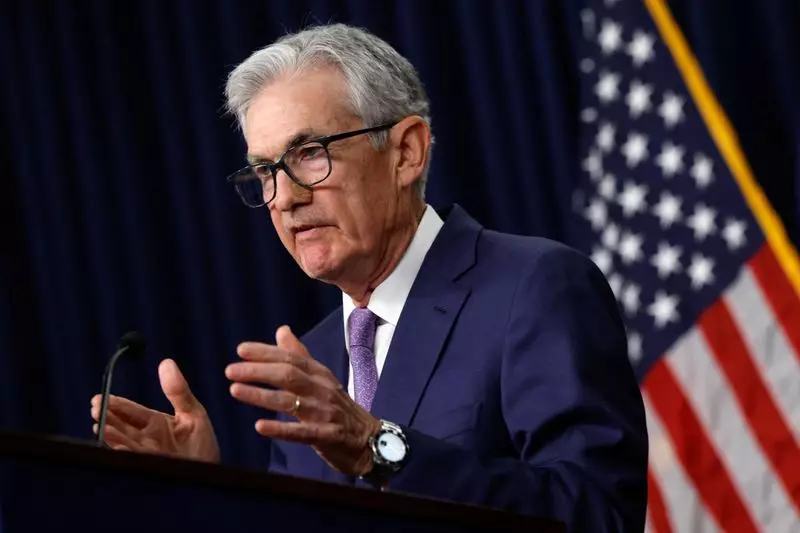As we approach 2025, Jerome Powell, Chair of the Federal Reserve, finds himself entrenched in a complex quagmire: the dual obligation to uphold the central bank’s independence while deftly sidestepping potential confrontations with the incoming Trump administration. The intricate nature of this situation becomes apparent as Powell works to steer monetary policy without overtly countering possible inflationary impacts stemming from the new administration’s financial directives. This critical balancing act has manifested sharply in recent months, reflecting the myriad challenges the Federal Reserve faces in a politically charged environment.
Recent projections from the Federal Reserve illustrate how the impending political landscape is beginning to seep into economic forecasting. In the wake of Trump’s triumph in the November elections, Powell took a firm stance against speculative risk assessment regarding future policies’ effects on interest rates. “We don’t guess, we don’t speculate, and we don’t assume,” he stated, setting a tone of caution during his November announcements. However, Fed projections have since begun to hint at conscious adjustments regarding anticipated monetary policy, suggesting that an alignment with the administration’s agenda has taken root. The Fed’s recent interest rate cut—an adjustment of a quarter point—completes a span of reductions totaling a full percentage point since September, underscoring heightened concerns over inflation pressures.
Yet, a notable shift in sentiment has emerged through updated forecasts, revealing an expectation of only two additional rate cuts in 2025, a drop from four previously anticipated. Inflation predictions have also climbed, with expectations now set at 2.5%, an increase from earlier estimations of 2.2%. The implications of these projections reveal a Fed grappling with influences beyond traditional economic indicators, hinting at the broader ramifications of the forthcoming administration’s policies.
Central to the Fed’s cautious stance is Trump’s incoming economic agenda, characterized by proposals such as increased tariffs and stringent immigration controls. Such measures are viewed as potential catalysts for elevated prices, compounded by expectations that tighter border policies could contribute to wage inflation through a reduced labor supply. While Powell has attempted to downplay the immediate impact of these policies, attributing concerns instead to the broader economic landscape, the palpable uncertainty surrounding the economic trajectory remains.
Moreover, the Fed is tasked with learning from past experiences, recalling the economic turbulence during Trump’s first term, which saw rate cuts enacted in response to trade disputes. The distinction between the current high-inflation environment and the historically low inflation backdrop of 2018 further complicates Powell’s strategic calculations. He posited in a recent press briefing that the Fed’s ongoing discussions are aimed at understanding the pathways through which tariffs may engender economic fluctuations. “What the committee’s doing now is understanding the ways in which tariffs can affect inflation,” Powell explained, reinforcing the Fed’s preparatory stance amidst impending policy shifts.
Advisors to Trump project cautious optimism that initiatives such as deregulation and enhanced energy production could mitigate inflationary effects. Treasury secretary-designate Scott Bessent has gone so far as to assert that tariff-induced price hikes would not lead to inflation, outlining a rationale that hinges on consumer spending patterns. This perspective, however, lacks consensus among economists, many of whom caution that the Fed will tread carefully, monitoring any reversal of supply-side improvements keenly.
As noted by experts like JPMorgan’s Michael Feroli, today’s economic climate is markedly different from the previous years characterized by sub-target inflation levels. This backdrop challenges the Fed’s operational paradigms, as analysts weigh the implications of businesses passing on rising costs to consumers. With employment levels at a premium, Ray Farris emphasizes that the implications for pricing strategies are unique; firms may feel empowered to adjust prices upward, contributing to a perception of persistent inflation.
As Powell maneuvers through a politically charged economic landscape, the Federal Reserve’s role becomes all the more critical. The challenge lies not only in maintaining its traditional independence but also in responding adeptly to the evolving economic scenarios while minimizing the fallout from political dynamics. As with any balancing act, the stakes are high, and the path leading into 2025 will be pivotal in shaping the economic realities for both the Federal Reserve and the broader American economy. The interplay between monetary policy and political strategy will inevitably shape how effectively Powell and his team can navigate the challenges that lie ahead, marking a significant chapter in the ongoing saga of U.S. monetary governance.

